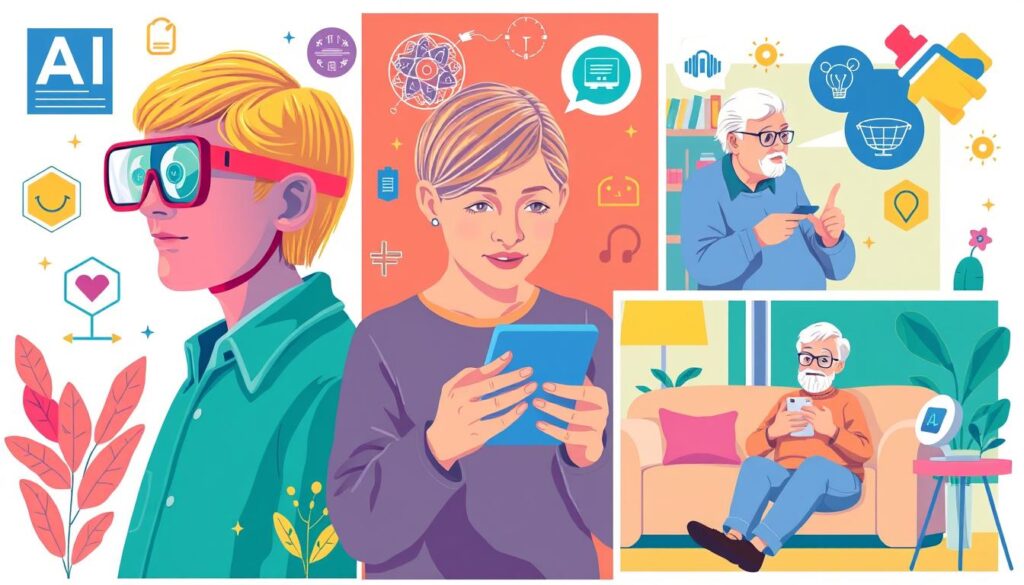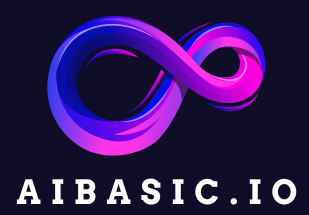AI Tools for Accessibility: Empowering Everyone
Did you know that businesses can miss out on about $1.9 billion in revenue if their web design is not accessible1? This shows how important AI tools for accessibility are. They can help companies and improve life for people with disabilities. The World Health Organization says over 2.5 billion people will need assistive technologies by 2030.
Currently, people with disabilities have about $13 trillion in disposable income. This makes making technology accessible not just a social need but also a big business chance1. AI is making things better for people with mental, physical, visual, or hearing impairments. It helps create a more inclusive workplace, making things better for everyone.

Key Takeaways
- AI tools enhance accessibility, unlocking potential for over 2.5 billion people by 2030.
- Inaccessible web design can lead to a significant revenue loss for businesses.
- Assistive technologies are pivotal in helping individuals with various disabilities.
- The inclusion of AI-driven solutions can transform workplace environments.
- Tapping into the $13 trillion disposable income of people with disabilities is essential for businesses.
- Collaboration with accessibility experts is vital for effective aid solutions.
The Importance of Accessibility in Today’s World
Accessibility is key for people with disabilities. About 16% of the world’s population has a disability. This shows how important it is for a big part of society2.
More people need assistive products, with up to 2.5 billion needing them worldwide3. As the population ages, this number could hit 3.5 billion by 20503.
Companies are now seen as responsible for making things accessible. They work to include everyone digitally. This helps users and boosts the economy, reaching a market of $13 trillion in disposable income.
AI makes things more accessible, like making captions for videos automatically2. It also helps those who can’t speak by turning words into text3. But, we need to keep improving AI to solve ongoing problems like captioning and voice recognition.
Understanding AI Tools for Accessibility
AI tools make digital spaces more inclusive for people with disabilities. They use assistive AI to improve how we interact with digital things. For example, generative AI helps make learning materials more accessible, fitting different learning styles4.
AI-generated content should include things like alt text for pictures and clear language. This makes it easier for everyone to understand4.
AI tools are designed to work well with assistive technologies. They make sure content is easy to navigate with a keyboard4. This is important for making sure everyone can use the content without trouble.
AI tools also help avoid biased language in content. This ensures that everyone is represented fairly4. As schools move to online learning, AI tools help by offering flexible assignments. These assignments can be less distracting and give more time to read, helping different learners4.
Tools like Stark and AccessiBe make checking for accessibility much faster. Stark offers checks up to 10 times faster, and AccessiBe starts at $49 a month for premium features5. Other tools, like Aircaption and Read Easy.AI, help with captions and making text easier to read. They are affordable and meet different learning needs5.
How AI Revolutionizes Communication for People with Disabilities
AI tools are changing the game for people with disabilities. They make it easier for them to talk and connect in different places. For example, Google’s Lookout and Be My Eyes use AI to help the blind by sharing what’s around them6. Also, speech tech lets people with speech or hearing issues talk better7.
Examples of Effective AI Communication Tools
Many AI tools are made for people with disabilities. ElevenLabs’ AI helped Congresswoman Jennifer Wexton speak again after she lost her voice6. AI also turns text into Braille and makes graphics touchable for the blind7. Tools like AI screen readers and voice assistants make digital content easy to get to.
Benefits of AI Voice Technologies in Workplace Inclusion
AI voice tech makes work places more inclusive. It helps everyone talk and work together. For example, AI guesses what you mean and fixes typos, helping those with mobility issues7. This way, companies can build teams where everyone feels included and valued.
Enhancing Learning Opportunities Through AI
AI has changed education, making learning fit for everyone. It uses special tools for students with different needs. These tools adjust learning paths, helping more students learn.
AI-Powered Tutoring Applications
AI tutoring tools meet students where they are, in learning. For example, text-to-speech helps students who can’t see by turning text into sound. It also helps students who can’t hear by adding captions and transcripts to lessons8.
Diverse Learning Solutions for Different Disabilities
Tools like Microsoft’s Immersive Reader help with language and reading. They’re key for students learning English8. There are also apps for braille and adaptive AI for teachers to make learning materials for all.
A survey showed most users of assistive tech feel left out in AI development. This shows how important it is to listen to users for better learning solutions9.
| AI Tools | Features | Target Users |
|---|---|---|
| Text-to-Speech Applications | Converts written text to audio | Visually impaired students |
| Real-Time Captioning | Captioning for live lectures | Hearing impaired students |
| Adaptive Learning Platforms | Personalized learning pathways | Neurodiverse students |
| AI Analytics | Data analysis for tailored feedback | All students |
Promoting Independent Lifestyles with AI
AI technology is key in helping people with disabilities live independently. Virtual assistants make daily tasks easier. They can schedule appointments and set reminders with devices like Google Assistant and Amazon Alexa. This freedom improves their lives and lets them fully enjoy their surroundings10.
Virtual Assistants Enabling Everyday Tasks
Virtual assistants are crucial for those with mobility issues. They help manage daily tasks and control smart home devices with voice commands. This makes life better and promotes a welcoming work culture11. It’s especially important as over two billion people with disabilities will need these technologies by 203010.
Workflow Automation for Disability Inclusion
Workflow automation brings big benefits to the workplace, making it more inclusive. Tools like robotic process automation (RPA) reduce boring tasks, boosting productivity. AI helps find skill gaps and design training, helping all employees grow12.
AI also keeps track of progress and makes adjustments for those with disabilities. This is key for keeping them in their jobs and helping them advance11.
AI-Powered Tools for Emotional Connection and Social Interaction
AI tools are changing how we connect emotionally and socially, especially for those who struggle with communication. They make it easier to engage through new interfaces, helping us form real connections. These tools are used in healthcare and personal relationships, making our interactions more meaningful.
How Communication Tools Foster Relationships
Emotional AI technology is making social interactions better. For example, chatbots use natural language to match our emotions, making us happier and more loyal13. They offer personalized help and advice, meeting our emotional needs14.
Wearable tech and apps help track our emotions to improve our well-being. They spot stress, anxiety, or depression early, helping us feel better13. In schools, emotion AI apps support students, making learning more engaging.
Emotional intelligence in communication tools makes our interactions deeper and more empathetic. They analyze our words and feelings, helping businesses connect better with us14. Companies like Cogito use voice analytics to understand customer moods, leading to better service13.
| AI Tool | Functionality | Impact |
|---|---|---|
| Emotion AI Chatbots | Tailors responses based on emotional analysis | Increases customer satisfaction and loyalty |
| Wearable Devices | Monitors emotional states for timely support | Enhances personal well-being and intervention strategies |
| Affectiva’s Automotive AI | Improves driver and passenger emotional experiences | Contributes to road safety and effective communication |
| Cogito Voice Analytics | Real-time mood assessment | Fosters empathetic customer service interactions |
AI tools not only fill communication gaps but also build lasting emotional bonds. They help people with disabilities connect better socially.
Addressing Accessibility Through Biometric Identification
Biometric identification is becoming key in making digital security better and more accessible for people with disabilities. It uses advanced biometric tech to make digital interactions easier. This includes facial and voice recognition, making logins simpler for those who struggle with passwords.
This change makes it easier for everyone to use digital services and get the info they need.
Enhancing Security and Navigation for Disabled Users
Biometric access control systems are getting better in many fields. They are very accurate, even with changes in appearance or damaged fingerprints15. Bosch’s biometric readers have also been tested for security to keep unauthorized access out15.
This creates a safe space for people with disabilities to be more independent.
The EU’s new AI Act will regulate biometric tech to ensure it’s used ethically16. Companies must follow this law, which covers many uses like identification and verification16. This law aims to make biometric tech safer and more reliable, helping everyone access digital services.
As things keep changing, using biometric identification makes digital security stronger and accessibility better for everyone17. It’s helping us move towards a more inclusive digital world17.
Incorporating Captioning for Enhanced Media Engagement
Adding captions makes media more accessible for everyone, including those with hearing issues. It boosts engagement by up to 20% in interactive media18. In schools, captions help students with different learning needs, like ADHD or language barriers.
The Importance of Transcripts in Educational Settings
Transcripts are key for students. Sites like Khan Academy and Coursera use captions and transcripts to help students18. This makes videos easier to search and understand, helping students learn better19.
It also lets students watch videos in a way that suits them best.
Impact on Business KPIs from Captioning
Using captions in videos can really help businesses. It lets more people watch videos, as over 80% of viewers on sites like Facebook watch videos without sound19. Tools like Rev and 3Play Media, and AI services, can increase sales and make marketing more accessible18.
This can make businesses more successful and reach more people in today’s market.
Accessible Design: The Digital Necessity
More businesses are moving online, making accessible design key for digital inclusion. Inaccessible websites can cost up to $1.9 billion each year due to user frustration20. Making sure websites follow ADA and WCAG standards is not just a legal must. It’s also a smart business move that makes all visitors’ experiences better21.
Statistics on Revenue Loss Due to Inaccessible Websites
Ignoring accessible design can lead to huge revenue losses. Here’s a table showing the financial hits of not following accessibility rules versus the gains of doing so:
| Aspect | Non-Compliant Websites | Accessible Websites |
|---|---|---|
| Average Annual Revenue Loss | $1.9 Billion | Increased Customer Retention |
| User Abandonment Rate | 60% | 30% |
| Conversion Rate | 2% | 5% |
| Potential Market Reach | Limited | Widely Accessible |
AI as a solution for Identifying Accessibility Issues
AI tools are great for finding and fixing website accessibility problems. They use automated checks to spot design issues that block user interaction22. With AI, companies can keep their websites up to date with accessibility rules21.

The Broader Impact of AI Tools on Society
AI tools are changing society in big ways. They help include people from all walks of life in different industries. These technologies make communication, learning, and work better for everyone. This is key for society to move forward.
Studies show that AI can make things more accessible. It makes sure everyone can use technology easily and in a way that feels right for them23. Tools like Microsoft’s Azure Cognitive Services and Google’s Live Transcribe help people with hearing loss. They make it possible to talk in real time at big events23.
This kind of technology is crucial for a workplace that values everyone. It helps create a place where everyone feels welcome and valued.
Promoting Inclusion Across Industries
AI is changing many areas of work, pushing companies to be more inclusive. With so many people using smartphones, making technology accessible is more important than ever24. Platforms like Coursera and LinkedIn Learning use AI to make learning personal. This helps people grow in their careers in a way that fits them23.
This change helps companies attract a diverse team. A team with different views and skills leads to better ideas and work.
Encouraging a Diverse Workforce
Having a diverse team is key for innovation. The International Labour Organization says 785 million people of working age have disabilities. This is a huge pool of talent for many fields24.
Companies that use AI to be more inclusive do more than just the right thing. They also get ahead by creating a place where everyone can thrive. The White House’s Executive Order on Diversity, Equity, Inclusion, and Accessibility shows how important this is24.
Future Trends in AI Accessibility Tools
The world of AI accessibility tools is changing fast. We need to make digital spaces more inclusive. New tech like brain-computer interfaces and augmented reality could make things better for people with disabilities. These advancements promise a more welcoming digital world for everyone.
Emerging Technologies and Innovations
More than 4% of websites are now accessible, up from 1.9% in 202025. This shows AI is making websites more open to everyone. Tools like accessWidget scan websites to check if they’re easy to use25.
AI helps find and fix problems like missing text, which is key for accessibility25. It also makes sure websites work well with keyboards and are easy to navigate25. AI tools like PAVE and PAC fix online documents so everyone can use them25.
AI is also making new gadgets for people with disabilities. For example, Meta AI glasses help the blind see their surroundings26. Apple’s Live Speech feature makes talking easier across devices26. Google’s TalkBack and AI in other platforms are changing how we interact online26.
About 1.3 billion people worldwide face significant disabilities27. But, 97% of websites are not accessible27. This is a big chance for AI to make digital spaces more open and inclusive27.
Real-World Success Stories of AI in Accessibility
Many AI accessibility projects show how tech changes lives for people with disabilities. They bring real benefits and share success stories around the world. These inclusive initiatives use new AI tech to make things more accessible on different platforms and tools.
Impactful Projects and Initiatives
More than 1 billion disabled people could live better lives with technology made for everyone28. For instance, voice assistants like Siri and Google Assistant make talking and getting info easier for those who can’t see well. AI apps like Ava and RogerVoice give instant text, helping those who can’t hear well join in talks28.
Also, AI helps prosthetics move better, giving users more freedom29. Smart homes with AI let visually impaired people control things with their voice29. These examples show how AI makes people more independent, helps them talk better, and improves their lives29.
As we keep moving toward a more inclusive world, these AI accessibility projects show us the way forward.

Conclusion
AI tools for accessibility are changing the game for inclusive technology. They help people with disabilities join fully in society. These tools make communication better, learning easier, and work more efficient.
Studies show that many image descriptions online are not helpful for those who can’t see. This makes it hard for them to understand. So, it’s important to have people check these descriptions to make sure they are right30.
New AI solutions are getting better at understanding speech. For example, Google and the University of Illinois are working together. They aim to make speech recognition better for everyone, not just those who speak normally31.
Tools like Google Lookout and Microsoft SeeingAI help people see and move around safely. They show how AI can make a big difference in our lives.
Looking ahead, it’s key for companies to use these AI tools to make the internet more fair. We need to keep working on making these tools better and more accurate. This way, we can make a society where everyone feels included3031.
MUST READ :https://aibasic.io/boost-productivity-with-ai-tools-work-smarter/
FAQ
What are AI tools for accessibility?
AI tools for accessibility are new technologies that help people with disabilities. They make communication, learning, and living easier. Tools like speech recognition and virtual assistants make spaces more welcoming for everyone.
Why is accessibility important in today’s digital landscape?
Accessibility is key because it lets everyone use digital content and services. It helps make the internet more inclusive. This way, everyone can access what they need online.
How do AI accessibility tools improve communication?
AI tools like voice recognition and automated transcription help people with disabilities talk better. They offer solutions that fit different needs. This makes talking and working together easier for everyone.
Can AI support learning for students with disabilities?
Yes, AI helps students with disabilities learn better. It uses tools that adjust to each student’s needs. This way, every student gets the education they deserve.
In what ways do virtual assistants contribute to independent living?
Virtual assistants like Alexa and Google Assistant help people with disabilities do things on their own. They make life easier by automating tasks. This improves their quality of life.
What role does captioning play in media engagement?
Captioning makes media more accessible for people with hearing issues. It also helps everyone understand content better. This can help businesses reach more people.
How can businesses ensure their websites are accessible?
Businesses should follow web design standards like ADA and WCAG. Using AI tools to check for issues can help. This makes websites better for everyone and can save money.
What are the societal benefits of promoting inclusion through AI?
Using AI for inclusion helps society by breaking down barriers. It encourages diversity and empowers employees. This leads to innovation and a better work culture.
What does the future hold for AI accessibility tools?
The future of AI accessibility looks bright. New technologies like AR and VR will make things even better. They will help make the digital world more inclusive for everyone.
Can you provide examples of successful AI accessibility projects?
Projects like those from Speechify and Microsoft show how AI can change lives. They improve inclusivity and quality of life for people with disabilities. These examples inspire others to make a difference.
Source Links
- AI and Accessibility | Empowering Every Online User – https://userway.org/blog/artificial-intelligence/
- Impacts of Artificial Intelligence (AI) on Web Accessibility – https://www.handtalk.me/en/blog/impacts-of-artificial-intelligence/
- Revolutionising Accessibility: The Role of AI in Assistive Technology – https://www.digitallearninginstitute.com/blog/revolutionising-accessibility:-the-role-of-ai-in-assistive-technology
- AI & Accessibility | Center for Teaching Innovation – https://teaching.cornell.edu/generative-artificial-intelligence/ai-accessibility
- Top 8 AI Accessibility Tools for Inclusive Design – https://adamfard.com/blog/ai-accessibility-tools
- AI’s Transformative Power: Revolutionizing Accessibility for People With Disabilities – NetChoice – https://netchoice.org/ais-transformative-power-revolutionizing-accessibility-for-people-with-disabilities/
- How is AI improving access and communication for individuals with disabilities? – https://www.linkedin.com/pulse/how-ai-improving-access-communication-individuals-yagnesh-pandya-lyyoc
- AI in Education: Enhancing Accessibility for All Students | OrCam – https://www.orcam.com/en-us/blog/practical-applications-ai-in-education-accessibility
- The Impact of AI in Advancing Accessibility for Learners with Disabilities – https://er.educause.edu/articles/2024/9/the-impact-of-ai-in-advancing-accessibility-for-learners-with-disabilities
- Council Post: Empowering Individuals With Disabilities Through AI Technology – https://www.forbes.com/councils/forbesbusinesscouncil/2023/06/16/empowering-individuals-with-disabilities-through-ai-technology/
- How AI Can Help People with Disabilities – https://neuronav.org/self-determination-blog/how-ai-can-help-people-with-disabilities
- AI Accessibility: what are AI assistive technology examples? – https://www.handtalk.me/en/blog/ai-accessibility/
- Understanding Emotional AI Functionality and Applications – https://convin.ai/blog/emotion-ai-in-modern-technology
- Emotion AI, explained | MIT Sloan – https://mitsloan.mit.edu/ideas-made-to-matter/emotion-ai-explained
- Biometric access control – https://www.boschsecurity.com/xn/en/solutions/access-control-systems/biometric-access-control/
- Analyzing the EU Artificial Intelligence Act: Spotlight on Biometrics – https://www.bakerdonelson.com/analyzing-the-eu-artificial-intelligence-act-spotlight-on-biometrics
- AI technologies: definition, use cases, ethics | IDEMIA – https://www.idemia.com/insights/why-artificial-intelligence-so-crucial-modern-identity-and-security-technologies
- Interactive Media Captioning: 10 Key Topics to Enhance User Engagement – https://waywithwords.net/resource/interactive-media-captioning-engagement/
- Beyond Accessibility: How Captions Can Enhance Video Engagement in Learning Environments – https://mediasite.com/blog/how-captions-can-enhance-video-engagement-in-learning-environments/
- Leveraging AI in Accessible Design to Transform Digital Learning – https://www.digitallearninginstitute.com/blog/leveraging-ai-in-accessible-design
- Accessible Design in the Age of Artificial Intelligence – https://www.accessibility.com/blog/accessible-design-in-the-age-of-artificial-intelligence
- AI for accessible design – https://medium.com/ai-first-design/ai-for-accessible-design-bbcf4dc57171
- Making AI Accessible and Inclusive – https://ryankmetz.medium.com/making-ai-accessible-and-inclusive-32ef2c279d47
- Accessibility and Artificial Intelligence: A More Diverse Future? – https://www.computer.org/publications/tech-news/trends/artificial-intelligence-and-accessibility/
- How AI Lead to The Rise of Web Accessibility Solutions – accessiBe – https://accessibe.com/blog/knowledgebase/ai-and-web-accessibility
- From Novelty to Necessity: How AI Could Open Up a World of Accessibility for Everyone – https://www.cnet.com/tech/mobile/ai-is-turning-phones-into-smarter-accessibility-tools-and-its-just-getting-started/
- Emerging Technology | The Rise of AI for Accessibility – https://userway.org/blog/emerging-technology-and-accessibility/
- Artificial Intelligence Enhances Accessibility for People with Disabilities – https://www.inclusivecitymaker.com/artificial-intelligence-accessibility-examples-technology-serves-people-disabilities/
- Transforming Lives: AI & IoT in Assistive Tech | Personal Stories – https://www.orcam.com/en-us/blog/personal-stories-ai-iot-transforming-assistive-tech-changing-lives
- Digital Accessibility Remediation: Can AI Tools Replace the Human Touch? – https://508institute.com/2024/01/17/digital-accessibility-remediation-can-ai-tools-replace-the-human-touch/
- AI for Accessibility: Opportunities and Challenges – Equal Entry – https://equalentry.com/ai-for-accessibility-opportunities-and-challenges/




Good web site! I truly love how it is easy on my eyes and the data are well written. I am wondering how I could be notified whenever a new post has been made. I’ve subscribed to your RSS which must do the trick! Have a nice day!
Severe hypermilers have increased their vehicles’ mileage by several times the Environmental Safety Agency (EPA) score.